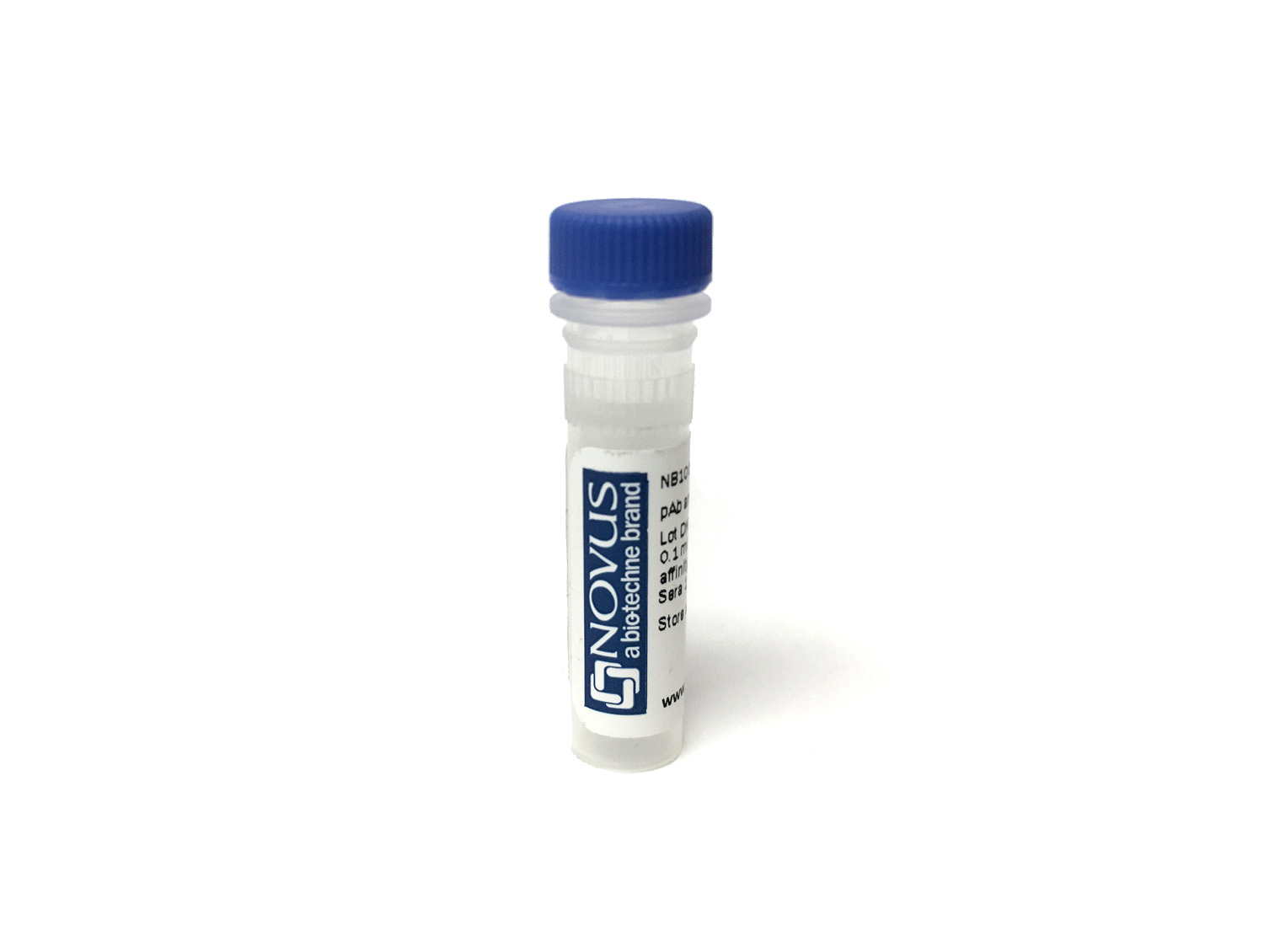TLR7 Antibody [DyLight 680]
Novus Biologicals, part of Bio-Techne | Catalog # NBP2-24906FR


Conjugate
Catalog #
Key Product Details
Species Reactivity
Human, Mouse, Rat
Applications
Bioactivity, Dot Blot, Flow (Intracellular), Flow Cytometry, Immunocytochemistry/ Immunofluorescence, Immunohistochemistry, Immunohistochemistry-Frozen, Immunohistochemistry-Paraffin, Immunoprecipitation, Proximity Ligation Assay, Western Blot
Label
DyLight 680 (Excitation = 692 nm, Emission = 712 nm)
Antibody Source
Polyclonal Rabbit IgG
Concentration
Please see the vial label for concentration. If unlisted please contact technical services.
Product Specifications
Immunogen
This antibody was developed against KLH-conjugated synthetic peptide corresponding to amino acids 706-749 of human TLR7; GenBank no. |AAF78035.1, AF245702_1. Cross-reactivity with mouse TLR7 shown. In human Ramos cells, additional bands are also seen.
Reactivity Notes
Use in Human reported in scientific literature (PMID:33806288).
Clonality
Polyclonal
Host
Rabbit
Isotype
IgG
Applications for TLR7 Antibody [DyLight 680]
Application
Recommended Usage
Bioactivity
Optimal dilutions of this antibody should be experimentally determined.
Dot Blot
Optimal dilutions of this antibody should be experimentally determined.
Flow (Intracellular)
Optimal dilutions of this antibody should be experimentally determined.
Flow Cytometry
Optimal dilutions of this antibody should be experimentally determined.
Immunocytochemistry/ Immunofluorescence
Optimal dilutions of this antibody should be experimentally determined.
Immunohistochemistry
Optimal dilutions of this antibody should be experimentally determined.
Immunohistochemistry-Frozen
Optimal dilutions of this antibody should be experimentally determined.
Immunohistochemistry-Paraffin
Optimal dilutions of this antibody should be experimentally determined.
Immunoprecipitation
Optimal dilutions of this antibody should be experimentally determined.
Proximity Ligation Assay
Optimal dilutions of this antibody should be experimentally determined.
Western Blot
Optimal dilutions of this antibody should be experimentally determined.
Application Notes
Optimal dilution of this antibody should be experimentally determined.
Formulation, Preparation, and Storage
Purification
Immunogen affinity purified
Formulation
50mM Sodium Borate
Preservative
0.05% Sodium Azide
Concentration
Please see the vial label for concentration. If unlisted please contact technical services.
Shipping
The product is shipped with polar packs. Upon receipt, store it immediately at the temperature recommended below.
Stability & Storage
Store at 4C in the dark.
Background: TLR7
While TLRs play an important role in innate immune response, dysfunction in the TLR-MyD88 signaling cascade has also been reported in various autoimmune disorders (5,6). Elevated expression of TLR7 is associated with increased risk of system lupus erythematosus (SLE), an autoimmune disease involving B cell hyperactivity (6,7). Studies involving mouse models has also found that increased TLR7 expression predisposes mice to a lupus-like disease (7). Therapeutics targeting TLR7 have been developed to either enhance or inhibit its activity depending on the circumstance. For example, TLR7 agonists such as imiquimod, resiquimod, and 852A are used to increase TLR7 activity for treatment of cancers and to fight viral infections (7,8). On the other hand, TLR7 antagonists inhibit its activation and have been developed to combat chronic immune stimulation as seen in inflammatory and autoimmune diseases (8).
References
1. Petes C, Odoardi N, Gee K. The Toll for Trafficking: Toll-Like Receptor 7 Delivery to the Endosome. Front Immunol. 2017;8:1075. https://doi.org/10.3389/fimmu.2017.01075
2. Maeda K, Akira S. TLR7 Structure: Cut in Z-Loop. Immunity. 2016;45(4):705-707. https://doi.org/10.1016/j.immuni.2016.10.003
3. Krieg AM, Vollmer J. Toll-like receptors 7, 8, and 9: linking innate immunity to autoimmunity. Immunol Rev. 2007;220:251-269. https://doi.org/10.1111/j.1600-065X.2007.00572.x
4. Uniprot (Q9NYK1)
5. Zheng C, Chen J, Chu F, Zhu J, Jin T. Inflammatory Role of TLR-MyD88 Signaling in Multiple Sclerosis. Front Mol Neurosci. 2020;12:314. https://doi.org/10.3389/fnmol.2019.00314
6. Chi H, Li C, Zhao FS, et al. Anti-tumor Activity of Toll-Like Receptor 7 Agonists. Front Pharmacol. 2017;8:304. https://doi.org/10.3389/fphar.2017.00304
7. Fillatreau S, Manfroi B, Dorner T. Toll-like receptor signalling in B cells during systemic lupus erythematosus. Nat Rev Rheumatol. 2021;17(2):98-108. https://doi.org/10.1038/s41584-020-00544-4
8. Patinote C, Karroum NB, Moarbess G, et al. Agonist and antagonist ligands of toll-like receptors 7 and 8: Ingenious tools for therapeutic purposes. Eur J Med Chem. 2020;193:112238. https://doi.org/10.1016/j.ejmech.2020.112238
Long Name
Toll-like Receptor 7
Alternate Names
toll-like receptor 7
Gene Symbol
TLR7
Additional TLR7 Products
Product Documents for TLR7 Antibody [DyLight 680]
Product Specific Notices for TLR7 Antibody [DyLight 680]
DyLight (R) is a trademark of Thermo Fisher Scientific Inc. and its subsidiaries.
This product is for research use only and is not approved for use in humans or in clinical diagnosis. Primary Antibodies are guaranteed for 1 year from date of receipt.
